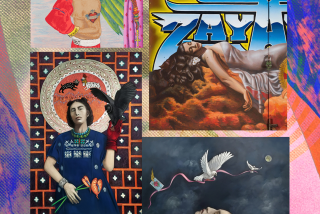STYLE / DESIGN : Art for Lifeâs Sake
When it comes to modern Latin American art, there are the celebrated paintings by artists such as Diego Rivera and Frida Kahlo, and then there is the contemporary art that embraces ordinary items decorated not for gallery walls but for day-to-day living. As seen in an exhibit that opened yesterday at the Natural History Museum of Los Angeles County, beauty isnât in the eye of the beholder; itâs in how traditional craftspeople transform modest materials into embellished objects that are used at work and play in their own communities.
âVisiones del Pueblo: The Folk Art of Latin America,â organized by the Museum of American Folk Art in New York, is a collection of eclectic pieces gathered from 17 countries. âIt wasnât like shopping through Sothebyâs catalogue,â says guest curator Marion Oettinger Jr. of the San Antonio Museum of Art. âI was going to communities that donât commodicize this stuff.â
Among the seldom-seen expressions of Latin American culture are ex-votos placed at shrines and churches in gratitude for blessings. In Brazil, theyâre carved from scrap wood; in Peru, from cheap metal. Most depict body parts once afflicted and now healed.
Ceremonial costumes of papier-mache, paint, feathers and animal hide play a role in other rituals. Animal motifs are popular, especially the centuries-old jaguar crucial to rain dances in Mexico and deer dances in Guatemala. Elsewhere, giant cardboard likenesses of government officials and folk heroes are hoisted overhead during Carnival.
Even functional objects are decorated and rarely ever strictly utilitarian. Panamanian walking sticks are handsomely carved and painted to signify the status of their owners, and Colombian shoeshine boxes are fashioned into miniature buses and other whimsical shapes to drum up business. Bolivian headbands, part of womenâs dress since pre-Columbian times, still feature plant and animal designs believed to endow the wearer with mystical powers.
Toys, created by ingenious young artisans as well as their elders, range from recycled-tin trains and cars to slingshots whittled into bird or human forms. And though actual breads, candies, floral arches and grave decorations couldnât be included in the show, photos document how these perishable and ephemeral works of folk art also permeate everyday life.
Altogether, the exhibit shows the countries of Latin America for what they are: as diverse as they are similar and as surprising as they are familiar. âMy goal,â Oettinger says, âwas to find things that Latin Americans themselves feel are important and use, and to find things that the American museum-going population has not seen before. I wanted desperately to not present the known.â
More to Read
The biggest entertainment stories
Get our big stories about Hollywood, film, television, music, arts, culture and more right in your inbox as soon as they publish.
You may occasionally receive promotional content from the Los Angeles Times.










